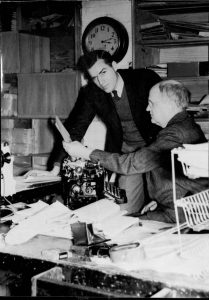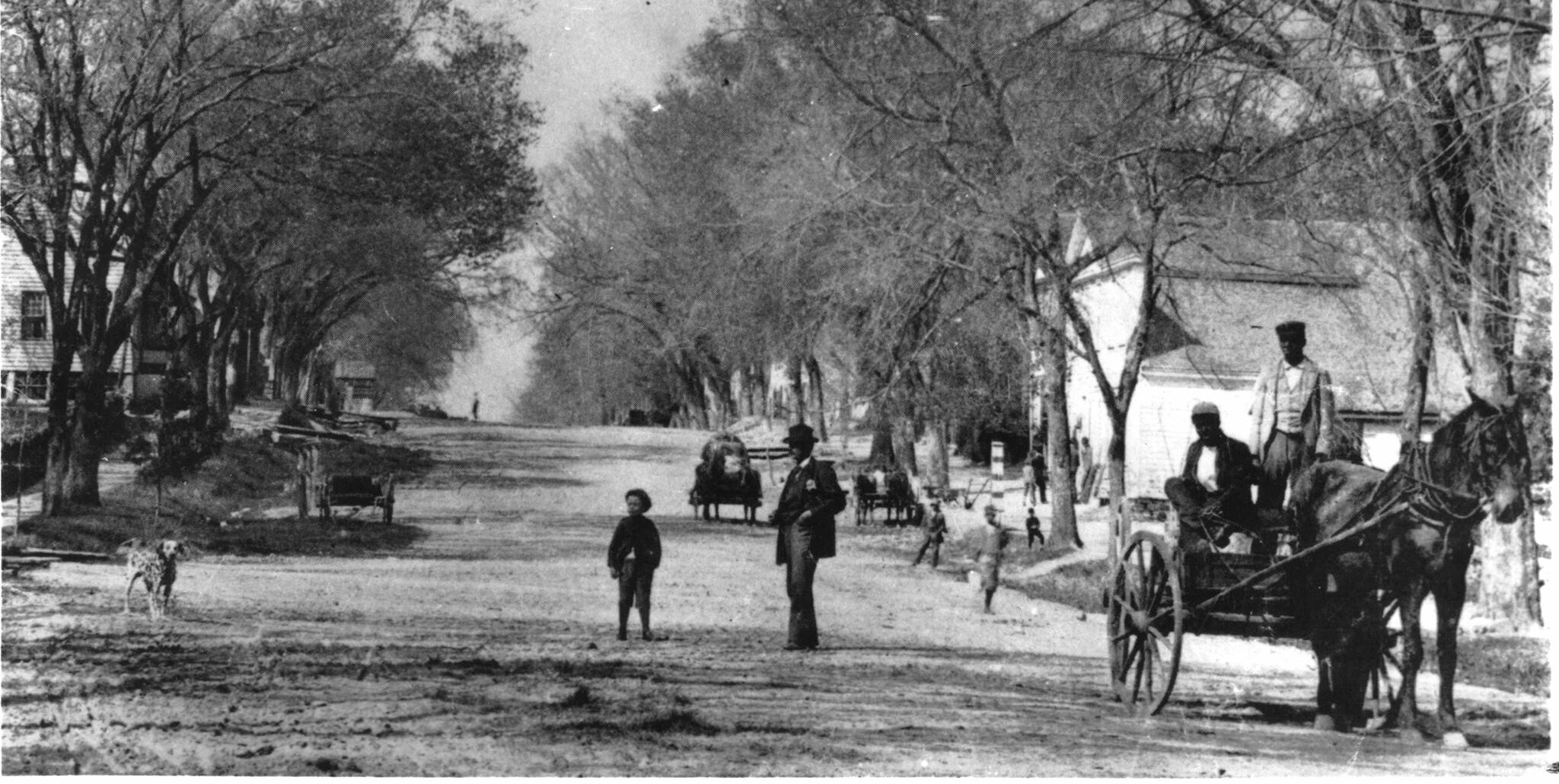The Purple Bowl

Louis Graves (seated) in Chapel Hill weekly office (Courtesy of the Louis and Mildred Graves Papers, North Carolina Collection, Wilson Library, University of North Carolina-Chapel Hill.)
Once the buzzing heart of Chapel Hill’s news, where typewriters clacked and headlines shaped the town’s mornings, this building now serves acai bowls to students and locals alike—its walls quietly holding the stories of a very different time.
This building once housed Chapel Hill Weekly, founded in 1923 by Louis Graves, UNC’s first journalism professor.[1] According to long-time resident Susan Worley, Graves was a, “wry and witty man with deep roots in Chapel Hill, who saw the community as a place that elevated academics, embraced eccentricity, welcomed difference, and a place that could laugh at itself.”[2]
Graves’ approach to journalism was deeply rooted in his belief in community engagement, and he saw The Chapel Hill Weekly as an essential tool for connecting the university and the town.
The Weekly was a bi-weekly publication that focused on local news, events, and issues affecting both the University of North Carolina and the Chapel Hill community. The newspaper covered issues that were close to the hearts of locals, such as the struggles of small businesses, the rise of new faculty at the university, the town’s evolving landscape, and the civic issues of the day. Most residents had the paper delivered but, like many newspapers, it was also sold in newspaper boxes outside of stores for a quarter.[3] The paper quickly became the town’s primary newspaper for several decades in the twentieth century. According to Worley, “there were plenty of light-hearted, anecdotal stories as well as more serious ones.”[4] National and non-local news was only reported as it related to Chapel HIll. For example, the article “Chapel Hill Mourns the Loss” was published days after John F. Kennedy was assassinated.[5]
In 1954, Orville Campbell, a UNC alum and former editor of the Daily Tar Heel, bought the paper and continued to platform local voices.[6] Campbell viewed the town of Chapel Hill with rose-colored glasses. According to Worley, “Campbell had a more rah-rah, boosterism approach to Chapel Hill”. His editor, Jim Shumaker, was revered in the journalism community and was the model of a long-running comic strip, Shu.[7] During the mid-twentieth century, Chapel Hill, much like America as a whole, underwent significant social and cultural changes. However, the civil rights movement was not heavily reported on by the Weekly. Most residents looked to the Daily Tar Heel for this topic.[8]

When asked about any memorable articles, Worley mentioned that Texas Gulf Sulfur was planning to come to Orange County to strip several hundred acres for copper mining. When the Weekly staff found out, they launched a campaign and mobilized town and university leaders against this plan. Worley attributes this campaign to stopping this plan and thus, saving Orange Country from potential physical devastation. [9]
In 1972, Campbell changed the name of the paper to The Chapel Hill Newspaper and expanded it to publish six days a week. Later, under new ownership, the name was shortened to The Chapel Hill News.
After Campbell’s death in 1989, the paper was sold and went through several corporate owners: first to Ottaway Newspapers (a subsidiary of Dow Jones) in the early 1990s, then to The News & Observer of Raleigh in 1993. In 1995, The News & Observer was acquired by McClatchy, which gradually moved editorial operations out of Chapel Hill and reduced the paper’s local focus. By 2017, only two reporters and one editor remained, all reassigned to The Herald-Sun in Durham. The paper officially ceased publication in January 2018.[10]
“Not having a local newspaper has had a huge impact on our sense of who we are as a community. With no one telling our stories, residents’ visions of the town are limited to their own personal experiences as opposed to communal ones and we are left isolated from one another,” explained Worley.
In 2024, The Purple Bowl relocated here from 306 West Franklin. A family business owned and operated by mother and son duo Paula and Taylor Gilland, The Purple Bowl serves acai bowls, artisan toast, and espresso drinks, making it a popular spot for students to grab a snack after a workout or relax with friends[11]

[1] Bernard L. Bryant, Occupants and Structures of Franklin Street, Chapel Hill, North Carolina at 5-year intervals, 1793-1998 (Chapel Hill: Chapel Hill Historical Society, 1999), 103
[2] Susan Worley in discussion with the author, May 2025.
[3] Ibid
[4] Ibid
[5]“Chapel Hill Mourns the Loss” Chapel Hill Weekly, November 24, 1963. https://newspapers.digitalnc.org/lccn/sn92073229/1963-11-24/ed-1/seq-1/
[6] “Orville Campbell” Chapel HIll -Carrboro Business Hall of Fame, Weebly.com, accessed March 5, 2025, https://businesshalloffame.weebly.com/orville-campbell.html#:~:text=Orville%20Campbell%20was%20one%20of,man%20certainly%20walked%20his%20talk.&text=Pulitzer%20Prize%2Dwinner%20Jeff%20McNelly,Press%20Association%20president%20in%201968.&text=memorial%20in%20Wilmington
[7] Susan Worley in discussion with the author, May 2025.
[8] Ibid
[9] Ibid
[10]Center for Innovation and Sustainability in Local Media. 2025. “Newsmaker Spotlight: The Life (and Death) of the Chapel Hill Times.” CISLM. Accessed May 6, 2025. https://www.cislm.org/newsmaker-spotlight-the-life-and-death-of-the-chapel-hill-times/.
[11] Olivia Gschwind “‘A new home’: The Purple Bowl to relocate on Franklin Street,” November 12, 2023. https://www.dailytarheel.com/article/2023/11/city-purple-bowl-moving-chapel-hill

